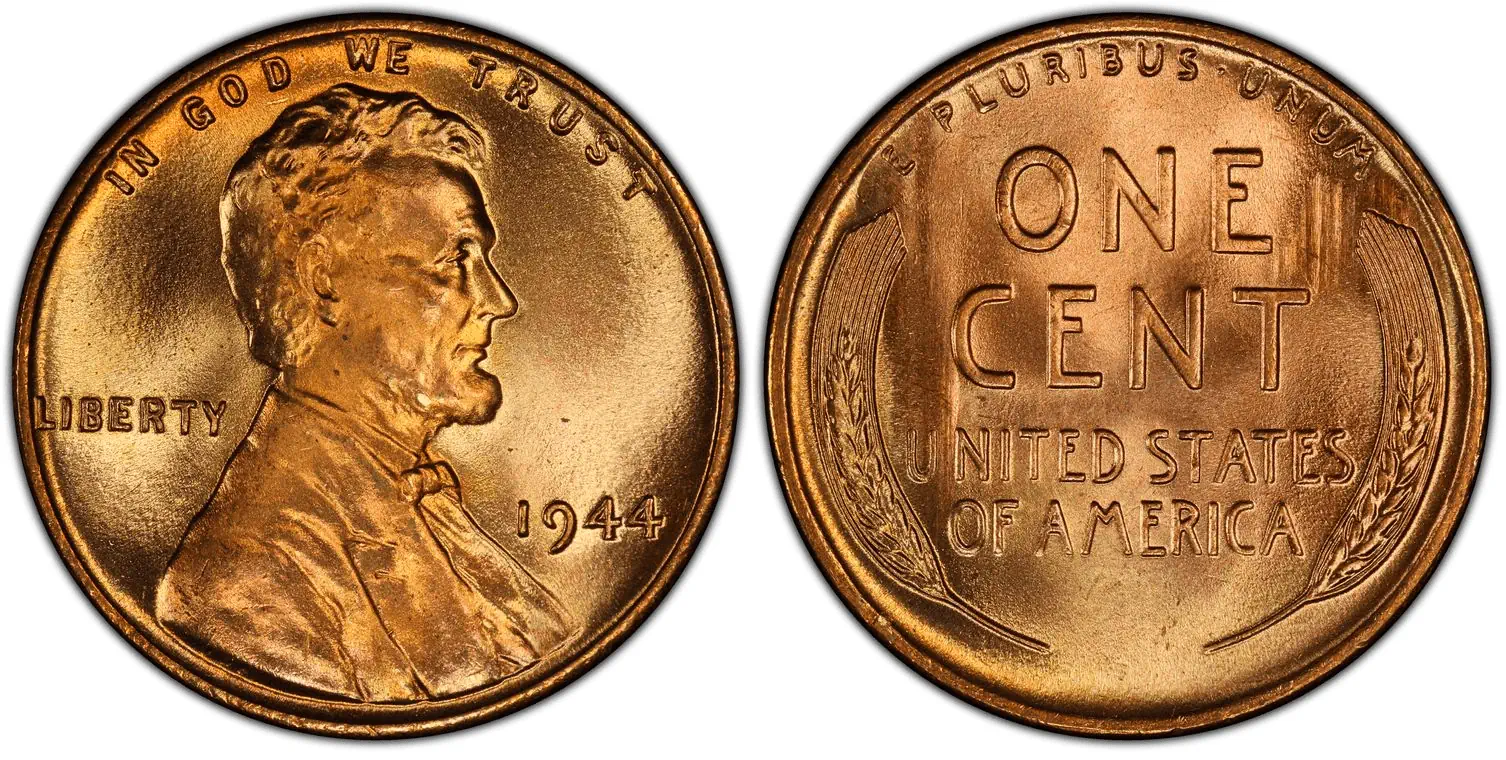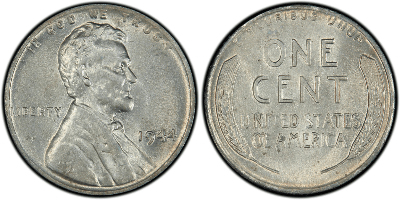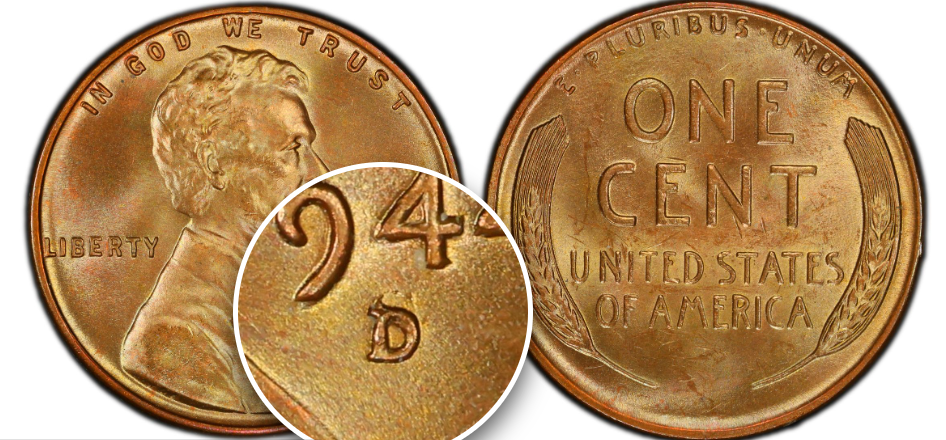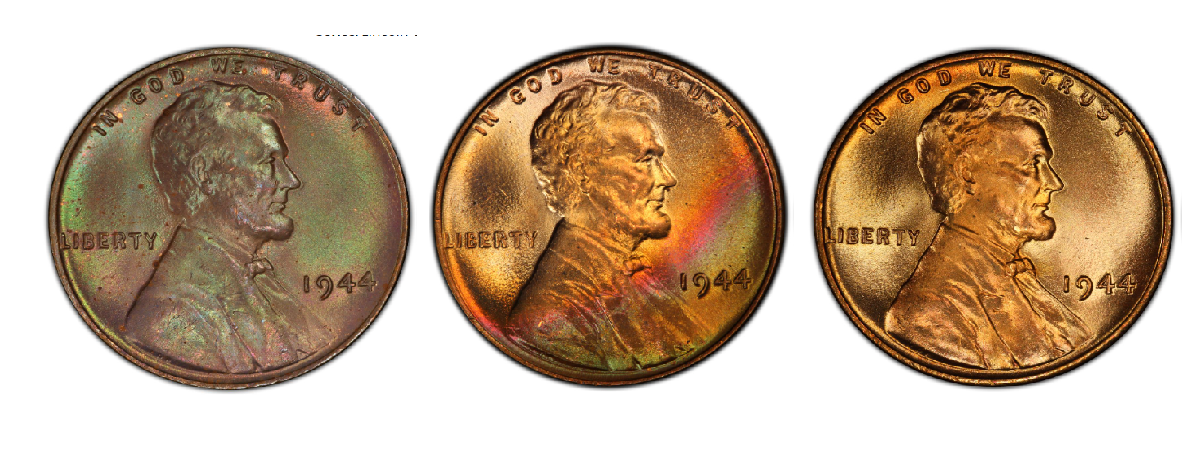Jump to: History | Design | Shell Casing | Value | Price Chart | FAQs
What is the 1944 Wheat Penny?
The 1944 Lincoln Wheat Penny is a cent designed by Victor David Brenner. It was well known as the return of copper to the Lincoln cents due to the unpopularity of the 1943 penny made of zinc and steel.
1944 was a new year for the Lincoln pennies using copper. But, they were not like the ones produced between 1909 and 1942, which included copper, tin, and zinc. The 1944 wheat penny had only copper and zinc in its composition. Because tin had become limited, it was removed from the composition of the wheat cents between 1944 and 1946.
It is important to note that in 1944, the US Mint created more than 2.1 billion pennies, a record. That makes the 1944 Lincoln cent one of the most common wheat pennies.
History of the 1944 Wheat Pennies
The 1944 wheat penny came as an answer from the government to the criticism the 1943 one-cent coins received. It was easy to mistake them for a dime, and they were prone to losing their zinc coating. So, the 1943 Lincoln steel cents were not very popular.
Interestingly, these steel pennies are the only regular-issue U.S. magnetic coins. This unique trait created unexpected problems with vending machines, which often used magnets to detect counterfeit coins. Unfortunately, these machines would mistakenly reject genuine steel pennies, since they, too, were attracted to the magnet. These factors led to the comeback of the original copper pennies in 1944.
The government decided that the 1944 wheat pennies returned to the familiar copper-based composition, 95% copper and 5% zinc, though tin was no longer included. This technically made them brass rather than bronze.
While a few 1944 steel wheat pennies exist, they were minting errors, likely struck on leftover steel planchets. These rare exceptions were not intentional and are now considered worth money by collectors due to their scarcity.
1944 Wheat Penny Design

Observing some features of this coin is essential to confirm the authenticity of a 1944 Lincoln cent. The first feature to observe is the portrait of President Abraham Lincoln on the obverse. This was the first U.S. coin to depict a real historical figure, despite the idea being once criticized by George Washington as too monarchical.
The year 1944 is stamped on the right side with the mint mark "D" (Denver mint) or "S (San Francisco mint) down below. The coins minted at Philadelphia bear no mint mark. On the left side of the image, the word LIBERTY is engraved, and on top is the traditional American motto, IN GOD WE TRUST.
On the reverse side, there are three inscriptions. Right in the middle is the capitalized denomination, (or face value) ONE CENT, right above the name of the country, UNITED STATES OF AMERICA, and on the outer rim, on the top, the Latin inscription E PLURIBUS UNUM.
WWII "Shell Casing" Cents: Fact or Fallacy?
There is a debate over whether 1944 pennies were made from recycled shell casings or if it is just patriotic folklore. While many dismiss it as a publicity stunt, wartime copper supplies did increase due to recycled ammunition.
Renowned numismatist Roger Burdette, however, cites National Archives records confirming shell casings were delivered by the wagonload to the Philadelphia Mint.
Understanding The 1944 Wheat Penny Value
Although the mintage of the 1944 wheat cent was one of the largest for that denomination, a series of conditions can raise its value to even five digits. For one, the 1944 wheat penny, even the regular strikes, are some of the most desired coins of all Lincoln Wheat Pennies.
It is a key date in coin collecting due to its history and connection to World War II. This appeal to collectors is what we call numismatic value. However, the condition of the coin is also of utmost importance.
Though a worn-out specimen will not bring you great profit, one 1944 Wheat Cent in fine condition could be worth up to $13,000! That's more than modern precious metals coins.
However, one variation of the 1944 Wheat Penny can be worth as much as a pot of gold. That is the 1944 Steel Penny.
1944 Steel Wheat Cent
After the change to copper in 1944, the US mint had some leftover steel blanks from the year before in the hoppers.
These incorrect planchets ended up in the pressing machines, resulting in a handful of steel coins bearing the 1944 mint year. That kind of minting mistake is called a transitional error.

1944 Wheat Penny No Mint Mark, produced at the Philadelphia Mint.
These error coins, made of steel instead of copper, hold a silvery color. Because of that, they are called "Silver Pennies," although they are not real silver coins, but zinc-plated steel, like the ones from 1943. Less than 50 specimens of the 1944 steel pennies exist, making them rare and valuable.
Most of these steel wheat cents come from the Philadelphia Mint and bear no mint mark. However, 7 of these steel wheat pennies have a “D” mint mark from the Denver Mint, and two more have the “S” from the San Francisco Mint, with the lowest mintage of the issue and the most valuable.
The auction record for a 1944 Steel Cent from the Philadelphia Mint was $180,000. One from the Denver Mint has sold for $115,000.
And, with a specimen sold for $408,000 (MS66) in 2021 via Heritage Auctions, the 1944 steel wheat pennies stand as the most valuable variety of the issue.
1944-D/S Wheat Cents
Though not as rare as the Steel Cents, the 1944-D/S Wheat Cents result from an error related to the mint mark that greatly influences these coin values.
Some of the 1944 Lincoln coins produced in Denver were made in a die with an “S” from the San Francisco Mint. On those error coins, the S was cleared out, and a D mint mark was placed on top of it, but traces of the mistake can still be found in some of them.


PCGS: Close-up of the initial “S” with the right mint mark “D” stamped over it.
A sample of these coins, still with their “reddish” coloration and highly graded in mint condition, can cost up to $57,500, according to PCGS appraisal experts.
In this article, we compare the most valuable pennies from 1945
How Much Is a 1944 Penny Worth?
1944 Wheat Penny Value Chart
To determine the actual price of the 1944 wheat penny, it is essential to consider its color designation and the coin's condition, which can be tricky. Still, it can help coin dealers and coin collectors assess its value more accurately. The coloration of the coin can be identified from left to right as:

-
BN (Brown) when it is a mostly brown copper coin with a 5% red surface or less;
-
RB (Red Brown) when it is a copper coin with a 5% to 95% red surface;
-
RD (Red) for a copper coin with over 95% red surface.
The MS (Mint State) is for coins certified in Uncirculated Grades. They are worth a significant amount above the circulated condition ones. Mint State grades can vary from MS60 to MS70 for a perfect coin. The "+" sign indicates that the coin is between two levels on the scale.

For instance, even in uncirculated condition, a coin dealer will pay more for a coin graded MS67+ than an MS67, but less so than an MS68.
|
DESCRIPTION |
DESIGNATION |
MS63 |
MS64 |
MS65 |
MS66 |
MS67 |
MS68 |
|
1944 |
RD + |
$8 $9 |
$14 $15 |
$18 $22 |
$28 $42 |
$200 $725 |
$13,000 |
|
1944 Steel Estimated 25-30 know |
MS + |
$87,500 |
$160,000 |
- |
- |
- |
- |
|
1944-D |
RD + |
$10 $12 |
$16 $18 |
$24 $28 |
$38 $75 |
$225 $575 |
$9,500 |
|
1944-D Steel 7 known |
MS |
$90,000 |
- |
- |
- |
- |
- |
|
1944-D/S |
BN + |
$450 $460 |
$500 $565 |
$650 $675 |
$850 |
- |
- |
|
1944-D/S |
RB + |
$450 $500 |
$625 $700 |
$1,000 |
- |
- |
- |
|
1944-D/S |
RD + |
$575 $615 |
$700 $1,100 |
$1,800 $2,000 |
$2,700 $14,000 |
$32,000 $57,500 |
- |
|
1944-S |
RD + |
$10 $11 |
$14 $15 |
$18 $20 |
$26 $40 |
$135 $1,050 |
- |
|
1944-S Steel |
MS + |
- |
- |
- |
$500,000 |
- |
- |
The price chart above has been updated according to PCGS's price guide and population.
Check also our article on the most valuable pennies ever sold.
1944 Wheat Penny FAQs
How can you tell if a 1944 wheat penny is steel?
There are two things to consider: magnetism and weight. A steel cent sticks to a magnet and is lighter than a regular copper coin. A steel penny weighs around 2.7 grams, while a copper and zinc penny weighs around 3.11 grams.
How do I know if my 1944-D penny is valuable?
A regular 1944-D Penny is generally worth $10 to $9,500 in uncirculated condition in the open market. The other coins, such as the 1944-D Double Die Error and the 1944-D/S Mint mark rare error, are extremely valuable, reaching up to 1,050 and 57,500, respectively.
How to clean a 1944 wheat penny?
Deep cleaning of any old coins is not recommended. For instance, it can potentially damage and reduce some of its value when in contact with chemical products or brushes. If it is covered by clay, a pure water gun is enough, and let it dry on a soft cloth.
Why is the 1944 penny rare?
The rare and desired pennies by most collectors are the clipped planchet error coins, mint mark errors, double strikes, and, of course, the 1944 steel cent known as the silver penny. Regular 1944 wheat pennies are not rare because they were minted on a large scale, so they are very common today.
How much is a 1944 Wheat Penny worth today?
As of May 2025, the price of the 1944 wheat penny fluctuates at around 13,000 for Philadelphia uncirculated coins, for Denver, 9,500; and for the San Francisco mint, which can be worth around 1,050 in uncirculated conditions.
Are there any rare 1944 Wheat Penny varieties?
The series has extremely rare minting errors besides the varieties of the different mints. Among them are double die errors and the notable 1944-D/S rare variety, where a D mint mark was struck over an S One of these mint mark error coins was sold for $49,937.50 at Legend Rare Coin Auctions. However, the most famous and valuable variety is the 1944-S Zinc-Coated Steel Lincoln Cent. This rare off-metal error fetched $408,000 at auction in 2021 due to its extreme scarcity and historical significance.
What is the difference between a 1944 copper and 1944 steel Wheat Penny?
Aside from its unusual steel composition, the 1944 steel penny stands out for its rarity and collector appeal as an off-metal error. This special coin was likely struck either on a leftover 1943 steel blank during the 1944 bronze cent production or on a steel planchet intended for a foreign coin that was accidentally mixed in. With only an estimated 25 to 30 examples known to exist, these rare coins are highly valuable. One sold for $180,000 at Heritage Auctions in 2021.
How can I tell if my 1944 Wheat Penny is in good condition?
The color of a wheat penny is one of the most noticeable indicators of its condition. Since copper is a reactive metal that oxidizes when exposed to air and moisture, the brighter and more vibrant the color, the better preserved the coin is likely to be. However, the most reliable way to assess a coin’s condition is through professional grading and authentication, significantly increasing its value.
How do I get my 1944 Wheat Penny appraised?
Reputable companies like PCGS and NGC provide detailed instructions on submitting coins for grading, including the types of services available, pricing, shipping rates, and proper packaging to ensure safe delivery. For more information, visit ngccoin.com/submit/how-to-submit for NGC or pcgs.com/submissions for PCGS.
Where can I sell my 1944 Wheat Penny?
Collectors commonly sell their coins through local coin shops or shows, where they can connect directly with dealers and fellow enthusiasts. Online marketplaces like eBay offer access to a broader audience, increasing the chances of finding interested buyers. For rare or high-value coins, auction houses such as Heritage Auctions or GreatCollections provide a professional platform with broad visibility and the potential for strong final bids.
What is the significance of the "D" or "S" mint mark on a 1944 Wheat Penny?
The 1944 Wheat Penny was produced at three different facilities of the United States Mint. The letters are mint marks representing the three mints. D for Denver and S for San Francisco. Coins without a mint mark come from Philadelphia, the first U.S. Mint, which traditionally did not use a mark, a practice maintained today.


















